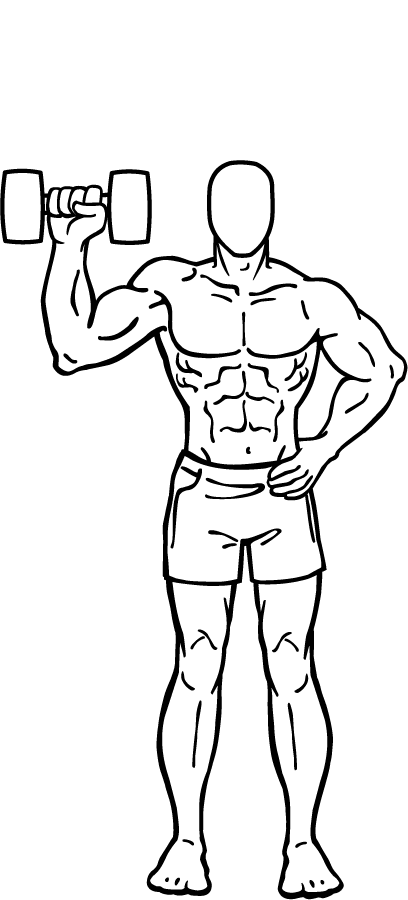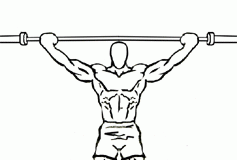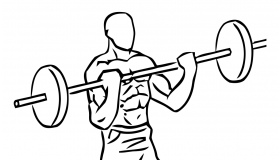Last Updated on December 27, 2001
The One Arm Dumbbell Shoulder Press is a staple exercise for developing shoulder strength and stability. This movement targets the deltoids and engages the core to enhance stability, making it ideal for anyone looking to build strength, balance, and functional fitness. Here’s everything you need to know, from proper form to tips for maximizing your results.
Why the One Arm Dumbbell Shoulder Press?
The One Arm Dumbbell Shoulder Press is unique because it involves pressing a weight overhead with only one arm at a time. This not only isolates and strengthens the shoulder muscles more effectively but also engages the core, lower back, and stabilizing muscles in the opposite shoulder to keep your balance. This exercise can provide:
- Shoulder Muscle Activation: Targets all three heads of the deltoid muscle (anterior, medial, and posterior), giving a fuller and well-rounded shoulder development.
- Improved Core Strength: By using one arm, the core stabilizers activate to maintain balance, helping you develop a stronger midsection.
- Enhanced Functional Strength: It mimics real-life movements where you might need to press or lift objects with one arm, making it ideal for functional fitness.
Muscles Worked
The One Arm Dumbbell Shoulder Press is highly effective for building strength and stability in:
- Deltoids (Shoulders): This exercise works the anterior (front), medial (side), and posterior (rear) parts of the shoulder.
- Trapezius (Traps): Assists in stabilizing the shoulder as you press the weight up.
- Triceps: Extends the elbow to lock out the weight overhead.
- Core and Obliques: Work to prevent your torso from leaning to one side during the movement, which helps to improve core stability.
How to Perform the One Arm Dumbbell Shoulder Press
Let’s dive into the step-by-step instructions to ensure you get the most out of this exercise.
1. Starting Position
- Feet Placement: Stand with your feet about shoulder-width apart. This stance provides a strong base for the press.
- Engage Your Core: Keep your abs tight and drawn in. This will help you remain balanced throughout the movement and protect your lower back.
- Hold the Dumbbell: With one hand, grasp the dumbbell, and bring it up to shoulder height with your elbow bent. Your palm should be facing forward.
2. Executing the Press
- Lift the Dumbbell: Press the weight upward by straightening your arm until it’s fully extended overhead. Be sure to keep your wrist straight and your elbow aligned with your shoulder to avoid any strain.
- Control the Motion: Do not let the weight fall back; maintain control as you lift.
3. Lowering the Weight
- Descend Slowly: Lower the dumbbell back to shoulder height in a controlled motion. Avoid dropping your arm too quickly, as this could lead to injury.
- Pause at the Bottom: Briefly pause at the bottom to reset and prepare for the next repetition.
4. Repetition and Sets
- Repeat for the desired number of repetitions, ideally between 8-12 reps per side for muscle growth, or higher reps for endurance.
- Aim for 3-4 sets, depending on your training goals.
Benefits of the One Arm Dumbbell Shoulder Press
1. Unilateral Strength
This exercise is unilateral, meaning it works one side at a time. This helps to address and correct muscle imbalances, allowing each shoulder to develop independently.
2. Improved Balance and Stability
Because you’re pressing with only one arm, your core and stabilizing muscles must engage more than in a two-arm press. This enhances your balance and functional stability.
3. Core Activation
To stay upright during the movement, your core (especially the obliques) must work hard to prevent your torso from tipping over to one side. This results in better core strength and overall stability.
4. Enhanced Functional Fitness
The one-arm movement mirrors real-life activities, where you might need to lift objects with one hand while stabilizing yourself. This adds a functional aspect to your training, making you stronger for everyday tasks.
Common Mistakes to Avoid
1. Leaning to One Side
Avoid leaning to the opposite side as you press the weight up. This can compromise your form and lead to injuries. Focus on staying upright and keeping your core tight.
2. Using Too Much Weight
Beginners often try to lift too heavy a weight, which can strain the shoulder. Start light, perfect your form, and gradually increase the weight.
3. Flared Elbow
Keep your elbow under control and in line with your shoulder. A flared elbow can put undue pressure on the shoulder joint, increasing the risk of injury.
Variations of the One Arm Dumbbell Shoulder Press
1. Seated One Arm Dumbbell Shoulder Press
Performing this exercise while seated reduces the need for core stabilization and allows you to focus purely on shoulder activation. It’s ideal if you’re looking to isolate the shoulder muscles.
2. Kneeling One Arm Dumbbell Shoulder Press
Kneeling adds a stability challenge and emphasizes core engagement. It’s a great way to advance this movement and test your balance.
3. Alternating Dumbbell Shoulder Press
If you want to increase intensity, alternate pressing each arm in a standing position. This keeps the muscles under tension for a longer duration, adding to the difficulty.
4. Landmine One Arm Press
For a different angle of resistance, use a landmine attachment. This changes the pressing path and is particularly useful if you’re looking to vary shoulder activation.
Tips to Maximize Your Results
- Warm-Up Properly: Before any shoulder workout, do dynamic warm-up exercises like arm circles or band pull-aparts to activate the shoulder joints and prevent injury.
- Use a Mirror for Feedback: Check your form by performing this exercise in front of a mirror to ensure that your torso stays upright and that you’re not compensating with other muscle groups.
- Incorporate a Full Range of Motion: Lower the dumbbell fully to your shoulder height with each rep, ensuring the muscle is working through its entire range.
- Progressive Overload: Gradually increase the weight over time to keep challenging your muscles. Consistent progress is key to strength and muscle growth.
When to Include the One Arm Dumbbell Shoulder Press in Your Routine
The One Arm Dumbbell Shoulder Press can be incorporated into your workout routine in multiple ways:
- Upper Body Days: Add it to your shoulder or upper body days to focus on shoulder strength.
- Full-Body Workouts: If you’re doing full-body workouts, this exercise is a great addition for upper body strength and stability.
- Strength Training Programs: Ideal for pushing days or strength-focused routines, especially if you’re training each muscle group once or twice a week.
Safety Considerations and Modifications
1. Shoulder Health
If you have any shoulder issues or impingement, consult a fitness professional before performing this exercise, or try lighter weights initially.
2. Proper Core Engagement
Make sure to engage your core fully to avoid leaning or twisting, which can put stress on your lower back.
3. Controlled Movements
Avoid jerking motions. Slow and controlled reps reduce the risk of injury and ensure that the muscles, rather than momentum, are doing the work.
Complementary Exercises for Shoulder Strength
Pair the One Arm Dumbbell Shoulder Press with these exercises for a well-rounded shoulder workout:
- Lateral Raises: Targets the lateral deltoids to create width in your shoulders.
- Rear Delt Flyes: Strengthens the posterior deltoids, improving shoulder stability and posture.
- Front Raises: Engages the anterior deltoid and helps with overhead press stability.
- Arnold Press: A variation of the shoulder press that also engages the chest and other supporting muscles.
Sample Shoulder Workout Routine
Try this routine to build shoulder strength, incorporating the One Arm Dumbbell Shoulder Press:
- One Arm Dumbbell Shoulder Press: 3 sets of 8-12 reps per side
- Lateral Raises: 3 sets of 10-15 reps
- Front Raises: 3 sets of 10-15 reps
- Rear Delt Flyes: 3 sets of 10-15 reps
Final Thoughts
The One Arm Dumbbell Shoulder Press is a fantastic exercise for building shoulder strength and stability while challenging your core and improving balance. Remember to start light, focus on good form, and be consistent. With the right technique, this exercise can become a powerful addition to your training program, helping you achieve stronger, well-defined shoulders and enhanced functional fitness.








